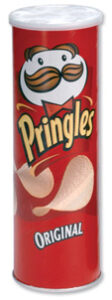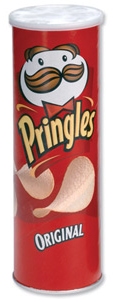The pleasure we derive from eating obviously depends on what food tastes and smells like. Visual presentation and colour are also important, as is the feel of the food in the mouth (i.e., its temperature and texture). But did you know that what a food sounds like can also determine how pleasant food tastes as well?

The latest research from Prof Charles Spence of Oxford University has shown that Pringles crisps (potato chips) taste better if they sound noisier when you bite into them. Participants in Prof Spence’s experiments had to bite into 180 Pringles crisps of varying freshness, while the sound that each crisp made was changed in real-time using a microphone, computer, and headphones. The results of this research, which was funded by Unilever Research, showed that people rated Pringles as tasting 15% fresher and crisper when the crisp sounds were made louder, or when just the high frequency components of the biting sound (above 2 KHz) were boosted. Prof. Spence and his colleagues have now gone on to show that it is not only the sound of the food that matters, but that the sound of food packaging can also influence our perception of crispness. Why else, after all, do you think that so many manufacturers sell crisps in such noisy packets?
The Pringles research, for which Prof Spence and Max Zampini were awarded this year’s prestigious Ig Noble prize for nutrition, is not as silly as it sounds. Indeed, many large food companies (such as Unilever who funded the original study and Nestle) have now started to conduct their own research in-house based on these findings. Prof. Spence’s research has also demonstrated that people’s perception of how carbonated a fizzy drink appears to be can also be modified by changing the sound; In the future, we may be able to reduce the amount of ‘tooth-rotting’ carbonic acid in fizzy drinks simply by changing the sound that the drink makes in the can. Prof Spence’s research may also suggest novel interventions to bring back the enjoyment of food for the growing elderly population who have started to loose their sense of taste and smell since there is currently nothing we can do to bring bask those senses once they have started to decline.
Finally, Prof Spence has been collaborating with Heston Blumenthal, the world-famous chef at The Fat Duck restaurant in Bray. Together, they have shown that you can flip the flavour of bacon and egg ice cream by changing the background sound – that is, it tastes more ‘bacony’ if you can hear the sound of bacon sizzling in a pan, while it tastes far more ‘eggy’ if the sounds of farmyard chickens are played instead. Even oysters taste nicer when they are eaten while listening to the sounds of the seaside (seagulls, waves crashing on the beach etc). One of the signature dishes on tasting menu at the restaurant, aptly named ‘The sound of the sea’ now involves diners being presented with a plate of seafood while listening to the seaside soundtrack via a pair of iPod headphones placed inside a seashell on the table. As Prof Spence says
Taken together, these results suggest that our perception and evaluation of food and drink depends not just on the taste, smell, sight touch and sound of the food itself, but also on the packaging, and even on the environment in which those foods are eaten.
For further information, please contact Prof Charles Spence or leave us a comment.



